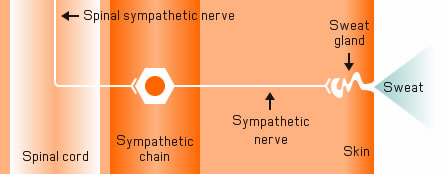If your palms sweat profusely, especially when you are nervous, or if you ruin your clothing because of underarm sweating, then you probably have hyperhidrosis.

Hyperhidrosis is defined as at least one episode of excessive sweating per week for more than six months, areas affected are the underarms, face, palms, and soles of the feet, and the episodes stop while you are asleep. Some people only sweat profusely in their sleep. These episodes are called night sweats. The most difficult aspect of hyperhidrosis is that it impairs your daily activities, preventing you from wanting to shake hands, to exercise, or to participate in certain social activities. It can also lead to difficulty in the normal activities of life such as handling paper, holding glasses or other slippery objects, or playing an instrument. Its impact on your life can range from the annoying (having to change your clothing or shoes frequently) to the dangerous (an electrical shock).
Causes
Factors that may trigger excessive sweating include stress, anxiety, and social situations and also environmental factors such as heat and humidity. It can be caused by illness or infection, obesity, or hormonal conditions such as an over-active thyroid, the menopause or diabetes. It can also be a side effect of certain medications, including SSRI anti-depressants such as Prozac.

Most people with hyperhidrosis have other family members with the disorder. Most sufferers are healthy with no underlying illness, and they are considered to have primary hyperhidrosis. Although most cases of hyperhidrosis are felt to result from over activity of the nervous system, that causes the sweat glands to produce too much sweat, they can also be associated with more serious illnesses. The more serious from of hyperhidrosis, called secondary hyperhidrosis, may be due to an illness with a high fever, a spinal cord injury, diabetes, substance abuse, an infection, cancer, or even disorders of the heart, lung, or brain.
Treatment & Management
Fortunately there are several effective treatments for hyperhidrosis, depending upon the severity of the condition. Treatment usually begins with topical prescription antiperspirants such as aluminum chloride hexahydrate, which is applied at bedtime to the affected area. These products work by blocking sweat ducts so that sweat does not reach the surface of the skin. In some people, aluminum chloride hexahydrate can lead to irritation, stinging, or burning of the skin. Using it at bedtime and washing it off the next morning can minimize irritation.
Botox injections have helped many who had despaired of finding an effective treatment.
Iontophoresis is also used to treat hyperhidrosis. It is a process in which an electric current is delivered to the affected area to block the sweat ducts. The hands or feet are placed on a metal plate and a current is delivered for approximately 30 minutes, 4 to 5 days each Week. An improvement may be observed after 5 to 10 treatments. Potential side effects may include irritation, dryness, or skin peeling. If topical agents are not effective in controlling sweating, injections of botulinum toxin into the underarm area, palms, or soles of the feet can dramatically decrease sweating; and the results can last for up to 9 months. It works by blocking the release of sweat from the glands. In the doctor’s office, botulinum toxin is injected into the affected area with a small needle. The entire process takes about 20 minutes, with results seen as early as one week after injection. Although the procedure may be uncomfortable or painful, numbing medication can be used to make you more comfortable. Although uncommon, side effects may include bruising, tenderness, or loss of strength in the hands if the palms are injected.
Surgical treatment for hyperhidrosis are used when the less invasive treatments are not effective. Surgery targets the nerves of the sympathetic ganglia that stimulate the sweat glands to produce sweat. The nerves may be cut, clamped, or burned to relieve sweating in the palms, face, soles of the feet, and underarms. Minimally invasive surgical procedures, such as Retrodemal Curettage or Laser Sweat Ablation, can permanently remove the sweat glands under the arms. Endoscopic Thoracic Sympathectomy (ETS) is major surgery with a high possibility of permanent damage and irreversible side effects.
Although this treatment is effective, serious side effects have been reported. The possibility of such side effects needs to be discussed with the doctor.
For more input:
Related Links:
- Top 10 Ways of Dealing with Stress
- Exercise: another excellent way to combat anxiety
- Tips For a Healthy looking skin
Disclaimer
The Content is not intended to be a substitute for professional medical advice, diagnosis, or treatment. Always seek the advice of your physician or other qualified health provider with any questions you may have regarding a medical condition.


